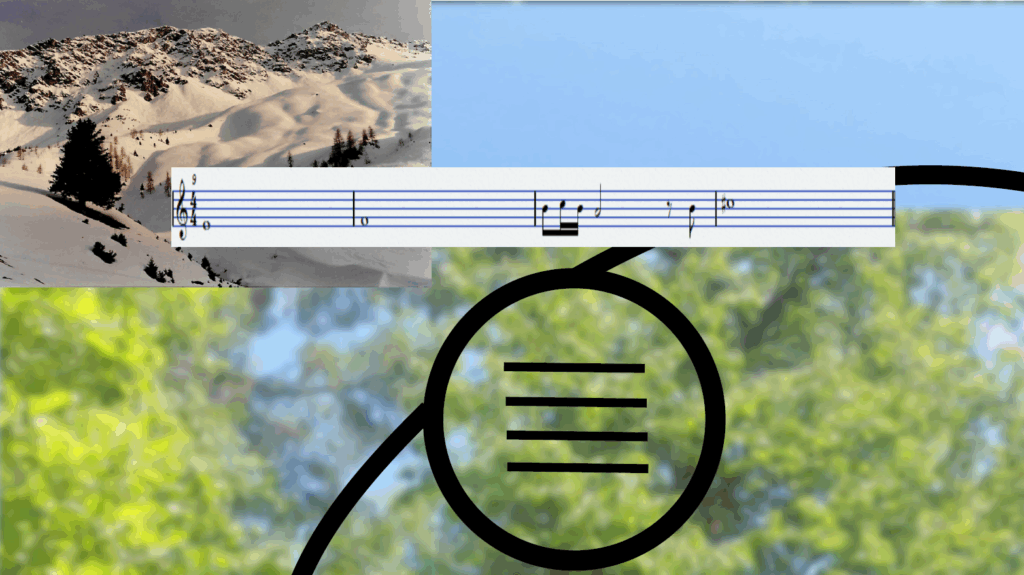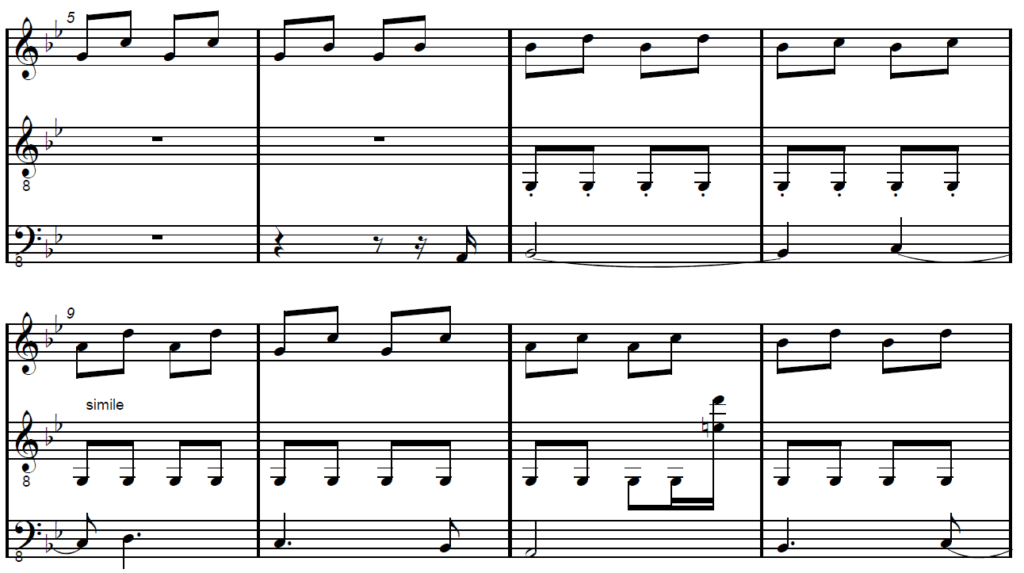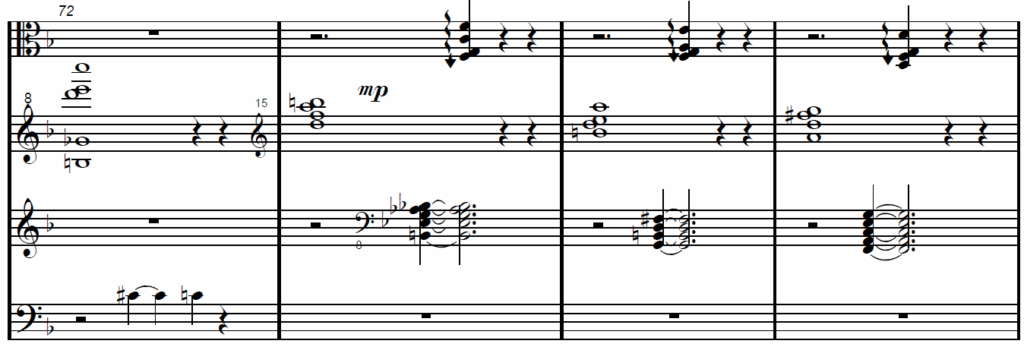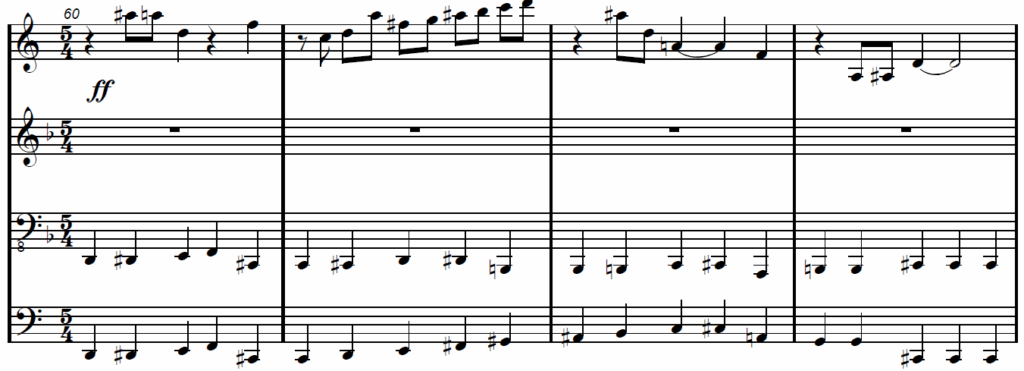The composition in MAX uses a thing called „Leitmotive“ (leitmotifs). Known from the opus of Richard Wagner. Let’s have a look through those – and strap in, because this is a complex and long explanation!

Why Leitmotive?
Starting to write for this project, it became clear quickly that I wanted to use a musical concept that somehow holds together the music, or rather ties the extramusical narrative and the various (pretty diverse) pieces of music.
There’s obviously actors – like Max, obviously, but also Erdmute and me. And there’s emotions, and Max‘ character traits. I thought about writing those leitmotifs, and then using them wherever it made sense from the extramusical narrative.
Anything special. No, they’re just melodic fragments – which also come with a rhythm and potentially an implied tonality and maybe even harmonic progression. So let’s look into those – and where and how they are used.
Overview
There’s a total of 13 leitmotive, called:
- MAX (the protagonist), Erdmute (his wife), Rainer (his son, i.e. me),
- Giesing (where he was born and died) and Riedering (the family relaxation spot in the countryside),
- Reise and Spiel (travel and game) as activities,
- Genie and Schelm (genius and jester) as character traits of his,
- Freude, Entspannung and Dunkelheit (joy, relaxation and darkness) as moods,
- and Biographie (biography) as a repeating statement to open narrative blocks.
Each of them has a different count of appearance – topping out the list is Schelm (6) and Genie (5), and near the end, Freude, Dunkelheit, Spiel, Riedering and Giesing are tied for two appearances each.
So let’s go through them and see where they make an appearance!
Max

A short succession of two times three triples ending in a sustained note, it implies a somewhat odd progression: written with one flat, this can be seen as D7 – Dmb6 – E. Or a lot of other things, its use in the score keeps the ambiguity.
It opens Erat Lausbub (and thus the album) verbatim,

and how it continues after that (moving to E dorian immediately to state the Giesing leitmotif) does not help to resolve the ambiguity.
It reappears both in the opening and in the closing section of Kaiseki, the latter of which is quoted here:

After opening the album, Max‘ leitmotif continues to end it: in the closing Ku section of Sapientia Salomonis, the motiv isn’t explicitly written into the score – rather referenced as „C“ to use as inspiration for the player’s improvisation:

Fittingly, the slow-moving pedal line and the high-pitched chords suddenly end, ending the piece (and the album) with just an improvisation over Max‘ motif with a fitting „morendo“:

Erdmute

Almost a marching groove, the repeated ascending intervals (first major thirds, then fifths) then move into a tritone substition turnaround, impying an almost normal F-Bb7-F-DbM7 progression.
However, its first appearance is pretty much hidden within the details of volles Brett (and Logis)‘ closing section:

A clear appearance happens in Sapientia Salomonis‘ Seiryu section – as a basis for improvisation:

Rainer

Not too dissimilar to the Erdmute leitmotiv, Rainer comes in in odd-meter, replaces the major 3rd with a minor one, and an implied minor dominant to go with it.
Only hinted at in Riedering very vaguely, the first easily visible appearance is in Kaiseki:

And the final appearance is during the improvised section in Sapientia Salomonis‘ Byakko – as a passive theme or bass line:

Giesing

A nice and catchy, folky theme resonates well with the worker (and football, home to FC Bayern and TSV 1860, with SpVgg Unterhaching right around the corner) districts of München.
It serves as the theme of the A section in Erat Lausbub, repeated in the reprise (excerpt):

Its second appearance – as the theme and basis for improvisation in Sapientia Salomonis‘ Byakko section – is true Counterpoint 101:

Yep, that’s a transposed version, augmented and in retrograde – from Unter- to Obergiesing.
Riedering

This one obviously makes an appearance in the non-standard score of the piece of the same name – Riedering:

It’s second appearance is as part of Sapientia Salomonis‘ Suzaku section – working as the theme and basis for improvisation:

Reise

Intuitively perceived as a 4+4+3+3 rhythmic structure, Reise feels like arpeggiated chords, and as such, lends itself to being used as harmonization, or a passive theme.
Its first appearance is within the progressive-rocking movements of volles Brett (und Logis) – again, a somewhat hidden one; focus on the implied chord progression here:

Notated in arpeggiated fashion, here’s the leitmotif appearing in the clarinet part near the end of Polarlicht:

Making rhythm simpler and tonality more complex, the last appearance is in Sapientia Salomonis in the second half of Genbu, marking Max‘ last big voyage (Reise) in the literal sense.

Spiel

„Spiel“ is mostly used for playing (and participating in matches in) football. Consequently, it’s first apperance is in Giesingpokal as the theme for the A section:

The second big match (this time, not for the Giesingpokal, but for a friendly match against the team of Greenland) is in Polarlicht (it also serves as an inspirational source for the big piano solo there):

(sidenote: enharmonic shift is a mess, as it was agreed that Neil, the ensemble lead, would do the score himself).
Schelm

Edgy, non-diatonic. This is a major part of Max‘ personality – „einprägsam individuell“ would be a more posh way to phrase „Schelm“ here:

As a result, this Leitmotiv is the one with the most apperances – starting as the theme for the B section for Erat Lausbub:

It immediately reappears as inspiration for the trombone part in section 6 of Landverschickung:

And as the second theme in the C section of the rondo in sechsspanning:

It reappears in Syracusa for charmante Überheblichkeit as the theme for the C section (incidentally, with a completely different harmonization):

And again, as inspiration (or second voice) for Carters Paranoia, maybe hinting at which character trait might have gotten the protagonist the opportunity to obtain legally-banned radio isotopes:

And Max went out in style – the last appearance is as the source of the improvisation for Sapientia Salomonis‘ Byakko section:

Genie

Much less catchy than Schelm, but in number of appearances only second to it – Max‘ genius runs through his entire life indeed.
There’s indeed a different, earlier version, and both make appearances:

Driving large horse carriages already as a child, it makes the first appearance for sechsspanning, or rather inspired two different sections – first, the main theme is derived from it (or rather, from an earlier version):

Next, the theme of the up-tempo section:

And later, the melody in the coda:

There’s no Giesingpokal without genius, so we see it again as inspiration for solos:

An alternate version forms the main theme of charmante Überheblichkeit (where it’s combined face-to-face with Schelm):

Derived from it, genius manifests in Carters Paranoia:

Closing the loop to the beginning, the horse carriage in Kaiseki’s narrative isn’t one without the leitmotif:

Freude

Jumping down, and then moving in an upwards motion. It first appears in Giesignpokal (winning this, according to Max, was his greatest accomplishment – which says a lot coming from a renowned scientist, chief surgeon and top manager):

And the second time we hear it is in Kaiseki’s closing section:

Entspannung

This (by this composition’s standards) catchy melody sees its first appearance as a strongly augmented version in the second guitar during volles Brett (und Logis) – let’s show the beginning:



It’s placed in full in the abstract beauty of Riedering as well:

And quite fittingly, in Kaiseki’s opening right next to Max‘ leitmotif:

Dunkelheit

Fortunately, there’s less Dunkelheit than Entspannung. The first appearance is in Landverschickung as the basis for a theme to be established by the trombone:

For the catastrophe that is Sapientia Salomonis‘ Suzaku section, it gets completely disassembled – can you spot it?

Biographie

More a chord progression than a theme or melody – this one implies Dm – Em – A7 – F – Cm7 – Db7 – Cm.
Its use in MAX is more one of structuring the narrative – a Mussorgsky-style „Promenade“ if you will, albeit almost always in a slightly different format. First, it closes Erat Lausbub for the transition into Morgensonne:

It makes a reappearance after the introduction to volles Brett (and Logis) – the beginning of which is shown here:

Its final showing is in Sapientia Salomonis – thrown in between the opening Genbu (which itself marks the passage between Abendsonne and Abendstren) and the following Suzaku:

